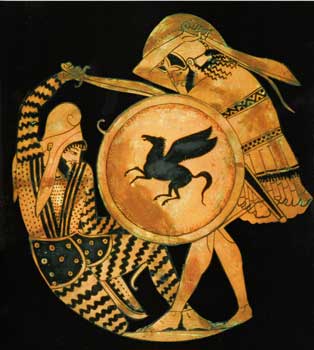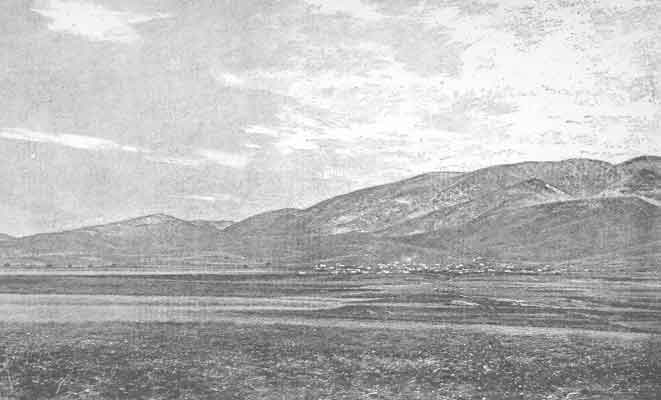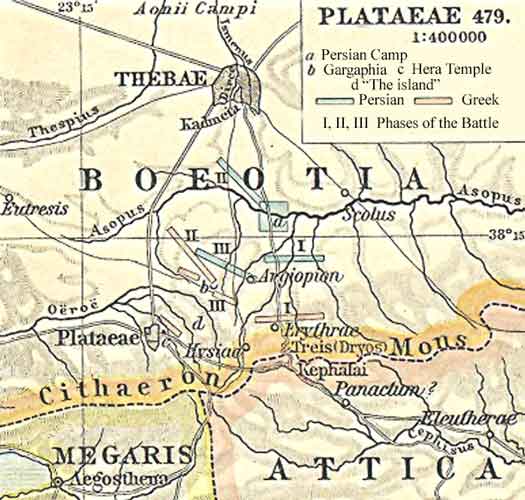.

|
Battle of Plataea |
||
|---|---|---|
|
Conflict |
Persian Wars |
|
|
Date |
August, 479 BC |
|
|
Place |
Plataea |
|
|
Result |
Greek victory |
|
|
Combatants |
||
|
Greek city-states |
Persia |
|
|
Commanders |
||
|
Pausanias |
Mardonius |
|
|
Strength |
||
|
110 000 |
300 000 |
|
|
Casualties |
||
|
159 |
257 000 |
|
|
|
||
|
Battle before |
Battle after |
|
The Battle of Plataea took place in 479 BC between an alliance of Greek city-states Sparta, Athens, Corinth, Megara, and others against the Persians.
Background
After the Battle of Salamis, Xerxes I returned to Persia, leaving Mardonius in charge of the conquered Greek territories. Mardonius, through Alexander I of Macedon, asked for a truce with Athens, offering autonomous government and Persian aid in rebuilding their city. Athens rejected this and asked for Spartan help, though the Spartans were more interested in protecting the Peloponnese. Mardonius then recaptured Athens, but Athens once more rejected his offer of peace. The Spartans hesitated as they were celebrating a religious festival, but eventually sent 40,000 men under the command of Pausanias to aid the Athenians. The Spartans knew the importance of this battle, it was the Greek city states fighting for their existence against the Persian forces. The Spartans fielded 5,000 Spartiates (full citizen soldiers); this was the largest single Spartan fighting force ever to appear in battle. Spartan forces typically consisted of relatively few actual Spartan soldiers, and mostly consisted of Perioci and soldiers provided from their allies. When Mardonius learned of the Spartan force he sacked Athens for a third time, then retreated to Thebes to await the Greek force.
Battle
Mardonius fortified the Asopus river in Boeotia, hoping that the Greeks would be unable to unite against him. However, the Athenians sent 8,000 men and marched with the Spartan force of 40,000 (5,000 Spartiates and 35,000 Perioci and Helots) to the pass over Mount Cithaeron, where they could successfully defend themselves from Persian raids. Mardonius sent a cavalry charge under the commander Masistius to take the pass, but Masistius was resisted by the Megarans and Athenians under the command of Olympiodorus. Masistius was killed and his cavalry retreated. The Greeks began to move away from the pass towards the plain of Plataea where Mardonius was camped, and where the Greek hoplites could fight more easily. The Athenians formed the left wing of the army during this movement while the Spartans formed the right wing and the Tegeans formed the middle.
By this point the Greek army had been reinforced by many other city-states, giving the Greeks a total strength of 110,000 men. Mardonius, on the other hand, according to Herodotus had 300,000 men. Both armies camped in front of each other for 10 days, with only small raids on each side. Finally Mardonius decided to attack, but the Greeks were warned of this by Alexander of Macedon. The Athenians and Spartans switched positions so that the Athenians would defend against the main Persian force while the Spartans would fight the Greek subjects within the Persian army. However, the Persians diverted the Greek water supply and cut off their supply of food, so the Greeks were forced to find a new camp.
On discovering the Greeks had abandoned their positions, Mardonius chased after them. The Persian cavalry and archers first came upon the Spartans, and the infantry arrived soon after. The cavalry and archers did little damage and moved off when the infantry arrived. The numerically superior Persian troops could not break through the Greek lines of hoplites, whose long spears gave them a tactical advantage over the Persian short spears and swords. The Persians were decimated; Mardonius himself was killed by a Spartan named Aeimnestus. The Persian Artabazus, who had unsuccessfully tried to convince Mardonius to avoid a pitched battle, took command of the Persian force and immediately retreated, allowing the Greeks to capture their camp. According to Herodotus only 43,000 of the 300,000 Persians survived the battle, while the Greeks as a whole lost only 159 men.

The Battle-field of Plataea.
Aftermath
According to tradition, the Battle of Mycale occurred on the same day, with the Greek fleet destroying the Persians in the Aegean Sea off the coast of Ionia. The Persian army, now under the command of Artabazus, retreated all the way back to Asia Minor after Plataea. This ended the Persian War, although the Persians continued to interfere in Greek politics until they were conquered in the 4th century BC by Alexander the Great. However, this was the last time the Persians tried to invade the Greek mainland with a goal of total conquest.
A bronze column in the shape of intertwined snakes was created from the treasure acquired in the plunder of the Persian camp, which commemorated all the Greek city-states who participated in the battle. Part of it still survives in the Hippodrome in modern Istanbul.
Images
Peter Green , The Greco-Persian Wars- , University of California Press; Reprint edition (August, 1998) ISBN: 0520203135
| Ancient Greece
Science, Technology , Medicine , Warfare, , Biographies , Life , Cities/Places/Maps , Arts , Literature , Philosophy ,Olympics, Mythology , History , Images Medieval Greece / Byzantine Empire Science, Technology, Arts, , Warfare , Literature, Biographies, Icons, History Modern Greece Cities, Islands, Regions, Fauna/Flora ,Biographies , History , Warfare, Science/Technology, Literature, Music , Arts , Film/Actors , Sport , Fashion --- |
Retrieved from "http://en.wikipedia.org"
All text is available under the terms of the GNU Free Documentation License




